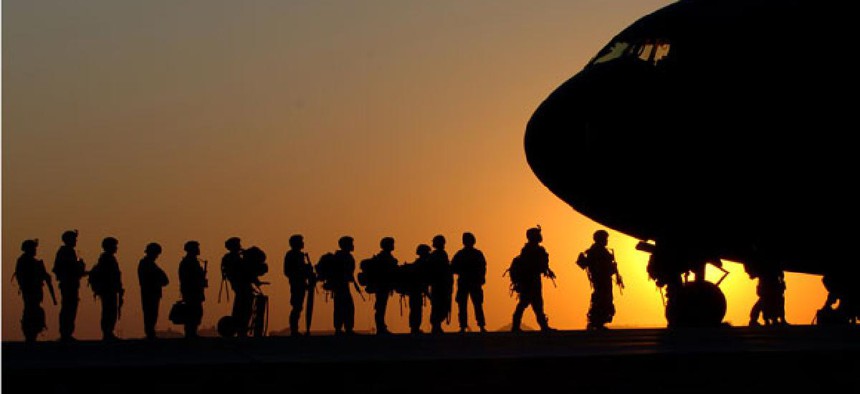Military Suicides Are Up, Despite 900 Prevention Programs

Defense Department file photo
Reducing the stigma of seeking mental health care is the key to prevention, witnesses tell lawmakers.
The Defense Department runs 900 suicide prevention programs, yet the number of military suicides has more than doubled since 2001, the head of the Pentagon’s suicide prevention office told lawmakers Thursday.
Jacqueline Garrick, acting director of the Defense Suicide Prevention Office, told the House Armed Services Committee that the Pentagon has identified 291 suicides in fiscal 2012 with investigations into another 59 pending. This is up from 160 in 2001. She said the suicide rate for 2012 is expected to increase once death investigations have been completed and a final manner of death determination is issued.
Lt. Gen. Howard Bromberg, Army deputy chief of staff for personnel, said the service had a record number of 324 potential suicides in 2012, more than double the previous record of 148 in 2009. Both Garrick and Bromberg said the military suicide profile matched that of suicides in the general population -- young, white males younger than 30 with only a high school education.
Eliminating the perception that seeking mental health care could cripple a career and lead to loss of a security clearance is one of the most “critical aspects” of suicide reduction, Bromberg told the hearing. He said there should be a top-down emphasis that seeking help is not a sign of weakness.
Rep. Joe Heck, R-Nev., who is also a physician and commands an Army Reserve brigade, said he has personal experience with soldier suicides -- one death and two attempts in his unit. He expressed frustration with the military’s inability to stamp out mental health care’s stigma. Heck noted that when he returned from Iraq in 2008, he asked, “Why are we still developing a stigma reduction campaign?”
Bromberg answered that erasing the stigma represents a “huge cultural change” for the Army. Lt. Gen. Darrell Jones, Air Force deputy chief of staff for manpower, personnel and services, said the Air Force has found a simple way to solve the stigma problem -- co-locate behavioral health specialists in the same clinics as primary care providers, enabling an easy handoff without anyone knowing a patient had gone to a separate mental health clinic.
The Army has started to embed behavioral health care providers in all its active duty operational units, which “has higher acceptability and satisfaction rates by both soldiers and supported leaders than conventional systems,” Bromberg said.
The Marine Corps has developed policies and programs to make all Marines responsible for the mental health of their fellow troops, Brig. Gen Robert Hedelund, director of Marine and family programs, told the hearing. “Marines are taught to know each other at a personal level -- to know their behavior patterns and their likes and dislikes so that they can identify even subtle changes,” and then aid them in seeking help if suicide warning signs occur, he said.
The Marines also operate a 24/7 anonymous peer counseling help line that “gives any Marine, attached sailor, or family member ‘one of their own’ to speak with about everyday stress or their heaviest burdens in life.” The Army has set up a confidential support crisis hotline that uses local cell phone providers in Afghanistan to connect soldiers at remote posts with peer counselors.
The Air Force is working with the Rand Corp. research company to determine how social media can help promote the emotional wellbeing of its personnel, Jones said. The Marines have kicked off a project to use text messaging to send supportive “care letters” to troops, Hedelund said.
Garrick said Defense has partnered with the Centers for Disease Control and Prevention and the Veterans Affairs Department to determine the cause of veteran and troop deaths back to 1979, including Guard and Reserve personnel. The department will use CDC’s National Death Index to develop a Suicide Data Repository.
Bromberg told the hearing that the Army has an “unprecedented” study under way to help it determine the factors and conditions that lead to soldier suicides. The Army Study to Assess Risk and Resilience in Servicemembers (STARRS), which kicked off five years ago, has analyzed information from nearly 40 Army and Defense Department datasets, spanning more than 1 billion records on all 1.6 million soldiers who served on active duty from 2004 to 2009, Bromberg said.
This is the largest study of mental health, psychological resilience, suicide risk, suicide-related behaviors and suicide deaths in military personnel ever conducted, he told the hearing, and it will help identify risk factors for suicide. The Army will then use this data to develop strategies to decrease the frequency of suicides, he said.
Rep. Carol Shea-Porter, D-N.H., wondered if Defense and the services have developed so complex a set of suicide prevention programs that troops “don’t know where to turn when they need help?”
In her prepared testimony, Garrick said her office has developed an automated resource management tool to help it track and assess the efficacy of the 900 suicide prevention programs. Those that don’t work will have their funding cut, she said.






